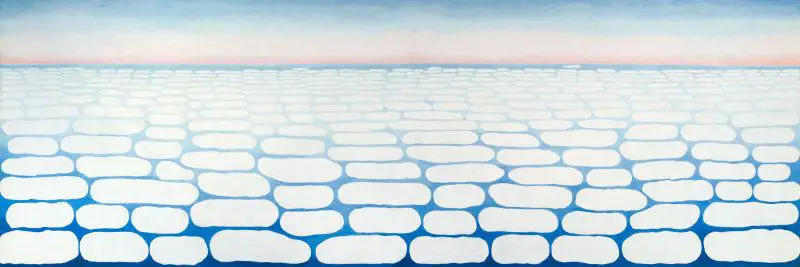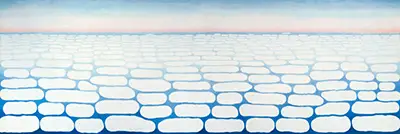We must consider the age at which this painting was created in order to understand how inspiring these views were to her. Air travel was still in it's relative infancy as a commercial enterprise during the 1960s and 1970s, meaning the artist would have felt even more excitement when peering through her cabin window. The artist covered the sky in different moods as again she would put the same objects under different conditions as she did with flowers, leaves and animal bones. The particular artwork was more of a mural, large scale and the sort of project that she had wanted to do for quite some time. Some of the previous cloud works were on a smaller scale. She tended to find a theme and attack it with innovation and experimentation across a number of pieces, before then moving on to the next topic.
The first thing to notice here is how the clouds are unnatural in their symmetry. They appear more akin to a series of tiles because of the way in which they are fairly equally sized and also consistent in how they come up to the edges of their neighbouring clouds, but just leaving a small gap between each one.
This small gap allows the tones of blue to come in from underneath, which one can presume to be the other parts of the sky. In the far distance we find a bright horizon which adds aesthetic interest and also helps us to picture what the artist was looking at when peering out of her window. Those fortunate enough to go on commercial flights at this time would have found these views extraordinary, and would not doubt have felt privileged to have witnessed them with their own eyes. Air travel and space travel were still distinctly rare at this time, afforded to only a very select few where as now one takes for granted these views because of the number of times that many people travel by air.
This is one of the largest Georgia O'Keeffe paintings, probably better termed a mural. It's dimensions are an extraordinary 243.8 cm tall by 731.5 cm wide - that is over seven metres in width! Few galleries would actually be able to display this piece, such it its size, but most of the major galleries have very large, flexible areas with which different styles of artworks can be put on show. The size also helps to get across the experience of seeing the great expanse of the sky when flying, and that is likely to have been the reason for O'Keeffe working from such a large canvas here. She was also much more experienced by this period of her career and so confident in trying to bold projects. Previously she might have worried about who would be willing to buy, or even display, such a large piece, but her reputation was now strong enough to allow her just to focus on her own creativity and expressing it in whatever ways she felt she wanted. Her health would start to suffer in later years too, so perhaps she felt a need to even increase her ambitions whilst she was still able to carry out these projects. Georgia O'Keeffe later described her thoughts around Sky Above Clouds IV and expanded on her decision to make such a large piece:
"...I painted a painting eight feet high and twenty-four feet wide—it kept me working every minute from six a.m. till eight or nine at night as I had to be finished before it was cold—I worked in the garage and it had no heat—Such a size is of course ridiculous but I had it in my head as something I wanted to do for a couple of years..."
The artist would start incorporating these scenes of clouds within her work from around 1963 and she would continually refine her ideas for a couple of years before taking on the piece that we find here. Her initial work was more faithful to reality, but clearly by this stage she had progressed into a fairly abstract style of depiction. This was the sort of path that many contemporary artists have taken, where they become less traditional as their confidence grows. The abstraction forms would also be the result of a process, never something that could be arrived at immediately and you will see the same in examples such as Mondrian's tree paintings, which slowly became less and less identifiable as time moved on. They came about when the Dutchman was moving from traditional landscapes to the later arrangements of brightly coloured squares and lines, the latter being what he is now most famous for. You will also find similar in Miro's career, who created an abstract language over time and reduced detail progressively over a period of several decades.
The artist was 77 years old in the year in which she produced her Sky Above Clouds series. Records show that this particular painting was unveiled at several major exhibitions of her work almost immediately. She was clearly happy with the final piece and willing to promote it. Amusingly, it was too large to move to one of the venues in which it was intended to be hung and so it was decided to remain at the Art Institute of Chicago, whilst they decided what to do. Years later, it seemed easier to simply gift it to the permanent collection here, and that is what was agreed. O'Keeffe was not someone too concerned with financial gain and so was happy to see her work gifted to some of these significant US art insitutions, even though she would reject payment in most cases. The positive today is that the prominence of these paintings with public collections means that we can all enjoy them ourselves, and that a strong focus will always remain fixed on her career.
This painting, one a of very successful series, can be found in the collection of the Chicago Art Institute, with most of this artist's paintings still residing in her native US. They themselves focus on contemporary art in areas of their gallery, but also possess some highly significant paintings from earlier periods, making it an excellent venue for learning more about the different aspects of art history. Whilst continually offering a rotating selection of exhibitions with pieces loaned in from elsewhere, their permanent collection is entirely sufficient by itself to excite even the most fleeting of art fan. You can enjoy the likes of Bathers by a River by Henri Matisse here, as well as the truly iconic Great Wave of Kanagawa by Katsushika Hokusai and also the highly relevant American Gothic by Grant Wood, which itself is one of the most recognisable American paintings in history. All in all, there is so much to see, with other art forms and periods also included, such as African sculpture too.

